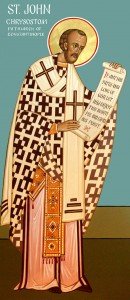 Churchman par excellence, St. John, Patriarch of Constantinople, is often regarded more as a moralist than a theologian. Such a view, however, which surely stems from the fact that Chrysostom’s greatest literary legacy is his homilies, apart from betraying a false distinction, also fails to take into account, and ascribe proper weight to, the profound theological influence of homiletic tradition upon the formulation of Christian doctrine. Homilies, of course, imply church services – Liturgy. The Eastern Church has also stressed the real relationship between faith and worship. The almost 3,000 homilies on Holy Scripture ascribed to John and his sermons are widely acknowledged as the real foundation upon which the homiletic tradition of the Eastern Church is based.
Churchman par excellence, St. John, Patriarch of Constantinople, is often regarded more as a moralist than a theologian. Such a view, however, which surely stems from the fact that Chrysostom’s greatest literary legacy is his homilies, apart from betraying a false distinction, also fails to take into account, and ascribe proper weight to, the profound theological influence of homiletic tradition upon the formulation of Christian doctrine. Homilies, of course, imply church services – Liturgy. The Eastern Church has also stressed the real relationship between faith and worship. The almost 3,000 homilies on Holy Scripture ascribed to John and his sermons are widely acknowledged as the real foundation upon which the homiletic tradition of the Eastern Church is based.
Now it seems that this assertion is no less true in the case of our thoughts on the Transfiguration of Christ. One of John’s homilies is the main source of our understanding on this event. It is the first homily on the Transfiguration in the history of the Church. Equally significant are the references to this event in a number of John’s other writings. They all shed light on his understanding of the nature and significance of the revelation on Tabor.
It seems that a number of other authors, such as Origen and Maximus the Confessor, helped shape John’s understanding of the Transfiguration Light. John, however, focuses on it in such a way as to signify considerably more than mere metaphor.
What is the nature and significance of the Light of Tabor as found in the writings of St. John? What does John have to say specifically about the Light of Tabor?
In a way which is highly reminiscent of Irenaeus, Bishop of Lyons, John’s appreciation of the Taborian revelation is fundamentally about our salvation and life as this earthly life. So as to prepare His disciples for the trials that they were about to endure in this life, Christ chose to give them a foretaste, concrete proof, of the heavenly blessings of which he had hitherto only spoken.
That which Christ had only spoken of, and which had not been revealed until the Transfiguration, was His coming again “in the glory of His Father”. The glory of the transfigured Christ, then, is a foreshowing of the Paternal glory in which Christ is to appear at the Last Day.
I shall continue to share some of the thoughts of John on the Light of Tabor.
They can give us insight into our faith!
